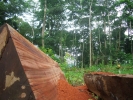 According to the Timber Industry Development Division (TIDD) of the Forestry Commission, wood and timber product exports from Ghana in January 2011 totalled 23,948 cubic metres valued at Euro 7.9 million, compared to 26,430 cubic metres and Euro 8.27 million in January 2010. This represents a decline of 9.4% and 4.4% in volume and value respectively.
According to the Timber Industry Development Division (TIDD) of the Forestry Commission, wood and timber product exports from Ghana in January 2011 totalled 23,948 cubic metres valued at Euro 7.9 million, compared to 26,430 cubic metres and Euro 8.27 million in January 2010. This represents a decline of 9.4% and 4.4% in volume and value respectively.
In January 2011, exports of all timber products declined except for plywood, moulding and flooring.
Exports of tertiary products were valued at US$902,209 in Janaury 2010, up steeply by 32% from US$ 681,275 in January 2010. Primary products, secondary products and tertiary products accounted for 3%, 86% and 11% of the total export value respectively.
In January 2011, the share of Ghana's exports of wood and timber products to other countries in Africa was 51% of the total export value, compared to 36% in January 2010. Exports to other destinations included Europe (26% of the total export value), Asia/Far East (15%) and the Middle East (5%). The main importing countries in Europe were Italy, France, Germany, the UK, Belgium, Spain, Ireland and the Netherlands.
Plywood accounted for 38% of the total exports of wood and timber products exports from Ghana in January 2011. Compared to January 2010, plywood exports rose 9.2% in volume and 32% in value. The main importing countries for Ghana plywood were Nigeria, Niger and Togo. Ceiba, Mahogany and Ofram were the principal species utilised for plywood production.
Ghana's forests are under pressure, and many Ghanaians believe action is needed if the forests are to survive. Ghana's tropical rain forest area is now just 25 per cent of its original size. Deforestation has occurred for a variety of reasons, including logging (a major drain on forest resources) and clearing the land to plant cash-crops.
Forest loss in Ghana has exacerbated droughts and bushfires. In 1997 and 1998, widespread bushfires led the government to step up its anti-bushfire campaign, but the reform had little effect. Desert is encroaching on some deforested lands and soil erosion is rampant. The economic development of Ghana has come at a great cost to its forests and environment.
The impact of deforestation is affecting the livelihoods of local people, and upsetting the fine balance of the forest's ecosystem. The tropical forests that cover the southern part of the country are vital for the environmental balance of the whole region. The impact of deforestation in Ghana is seriously jeopardising the future of the country. If extraction continues at the present rate, the forest will be gone in the next 45 years.
Deforestation is also changing the habitats of disease-carrying insects and creating conditions that may help to spread malaria, river blindness and other devastating illnesses. The worms that causes river blindness or onchocercosis, are transmitted mostly by cytoforms of a blackfly (Simulium damnosum) found in savanna regions. These cytoforms are beginning to spread into areas of cleared forest in Ghana.
According to data from the World Resources Institute, Ghana has 3,725 species of plants, 729 birds, 222 mammals, 131 reptiles, and 90 fish.
In 2006, scientists have discovered in Ghana significant populations of new, rare and threatened species in one of the largest remaining blocks of tropical forest in West Africa, reports Conservation International (CI). The findings underscore the need to conserve the area's high biological richness. The discoveries include a Critically Endangered frog species (Conraua derooi) whose presence in Atewa may represent the last viable population in the world; an unusually high 22 species of large mammals and six species of primates including two species of global conservation concern: Geoffroy's pied colobus (Colobus vellerosus) and the olive colobus (Procolobus verus); 17 rare butterfly species; six bird species of global conservation concern including the brown-cheeked hornbill (Bycanistes cylindricus) and the Nimba flycatcher (Melaenornis annamarulae)(first time recorded in Ghana); and nine species new to science: a spider tick whose lineage is as old as the dinosaurs and eight species of katydids.


